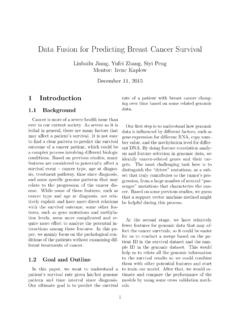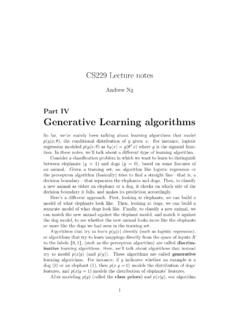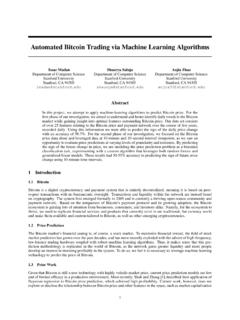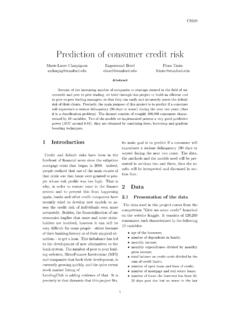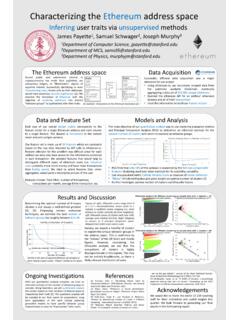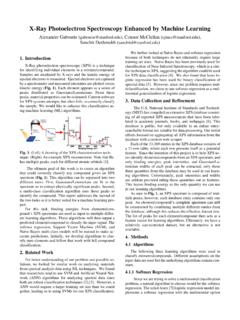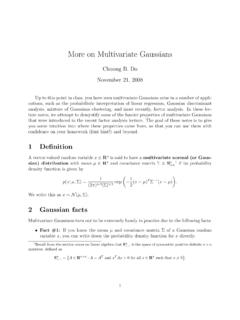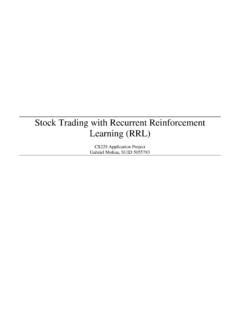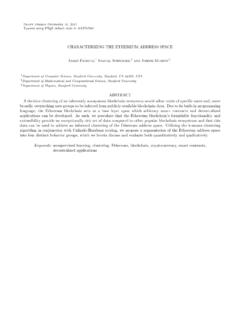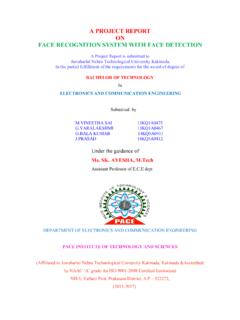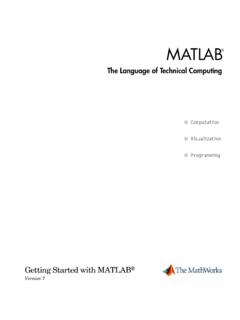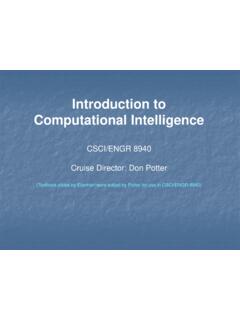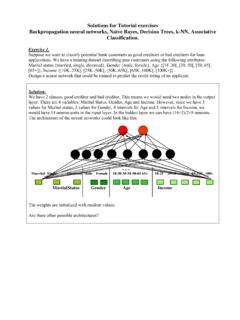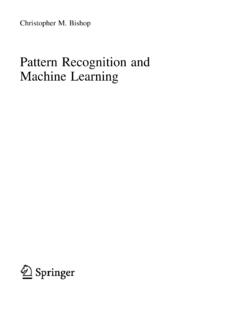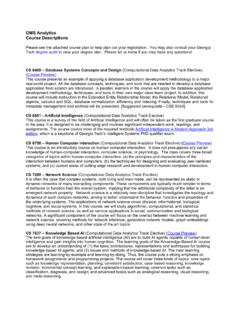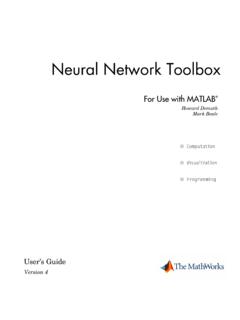Transcription of Time Series Sales Forecasting - Stanford University
1 1 time Series Sales Forecasting James J. Pao*, Danielle S. Sullivan** Abstract The ability to accurately forecast data is highly desirable in a wide variety of fields such as Sales , stocks, sports performance, and natural phenomena. Presented here is a study of several time Series Forecasting methods applied to retail Sales data, comprising weekly Sales figures from various Walmart department stores across the United States over a period of approximately 2 and a half years. Significant surges in Sales are noticeable in the data during pre-holiday and holiday weeks, which present a challenge for any developed Forecasting models. The prediction models implemented herein are regression decision trees, Seasonal-Trend Decomposition using Loess and Autoregressive Integrated Moving-Average (STL + ARIMA) models, and time -lagged feed-forward neural networks (FFNNs).
2 In particular, the STL + ARIMA and the time -lagged FFNN s performed reasonably well in Forecasting the weekly Sales data. The best FFNN implementation, using a time -lag value d = 4 and mean weekly Sales as inputs, achieved a mean absolute error of 1252. Weekly Sales for the store departments are in the tens of thousands. It is also notable that the results achieved by the time -lagged FFNN s did not require any deseasonalizing of the Sales data, indicating that neural networks may be able to effectively detect and consider any seasonality during training and prediction. 1 INTRODUCTIONN a world today where competitive margins are becoming increasingly narrower and actions must be decisive yet informed, the ability to accu-rately make forecasts is of premier importance.
3 This is certainly true in the Forecasting of numeri-cal data such as the health of a country s economy or the movements of a stock market from day to day. Forecasting is even beneficial in domains such as environmental monitoring or sports perfor-mance, and, accordingly, much Forecasting work has been done across a broad swath of exciting fields and disciplines. A more traditional yet still thoroughly compel-ling application of Forecasting is Sales prediction, which is the focus of this work. As markets become more and more global and competition is ruthless, optimizing an organization s operational effi-ciency is of premium importance. When compa-nies must spread their resources broadly and con-sumers have a surfeit of choices, every advantage a company can squeeze out will make a difference.
4 If a company can match the demand of a product with just the right amount of supply, then there will be no lost Sales due to a lack of inventoy as well as no costs from overstocking. Sales forecast-ing uses patterns gleaned from historical data to predict future Sales , allowing for informed courses-of-action such as allocating or diverting existing inventory, or increasing or decreasing fu-ture production. This work investigates the performance of a va-riety of predictive models for the application of de-partmental Sales Forecasting . As a baseline method, a regression decision tree is implemented. Then, the more sophisticated models of Seasonal-Tre n d Decomposition using Loess and Autoregressive Integrated Moving-Av e r a g e ( S T L + A R I M A ) and feed-forward neural networks using time -lagged inputs were used.
5 2 RELATED WORK Two currently popular approaches to nonlinear time Series prediction problems are statistical ap-proaches using ARIMA and machine learning ap-proaches using Artificial neural Networks (ANNs). ANNs have shown to perform well in time Series Forecasting because of their ability to accurately represent non-linear data [1]. Both of these approaches have had success when applied to Sales Forecasting and stock predictions [2]. When applied to financial data, the ARIMA model is able to leverage the fact that financial time Series data is generally related to past values [3]. Provided there are no sudden changes in value or behavior, an ARIMA model will also be very effec-tive for financial time Series Forecasting [4].
6 In his 2010 paper Adebiyi [4] applies the ARIMA model to accurately forecast the Nokia stock prices. It is important to note that the linear assump-tions of the ARIMA model have resulted in poor Forecasting models in cases of stock price predic-tion when the dataset includes values coming into and coming out of an economic recession (chang-ing properties). I 2 In a separate paper Adebiyi [2] implements an ANN model and an ARIMA model to to predict Dell stock prices. In his model comparison, the ANN slightly outperforms the ARIMA model. Adebiyi attributes this partially to the fact that the ARIMA model assumes that the times Series is generated from a linear process.
7 3 DATASET The dataset used was provided by Walmart Inc., an American multinational retail corporation, for a 2014 data science competition (Kaggle). The dataset contains historical weekly Sales data from 45 Walmart department stores in different re-gions across the United States. The training set has 421,570 samples. Each sample has the following features: departmental weekly Sales , the associated department (81 departments, each listed as a num-ber), the associated store (listed as a number), the store type, the date of the week s start day, a flag indicating if the week contains a major holiday (Super Bowl, Labor Day, Thanksgiving, Christ-mas). Also supplied is a corresponding set of features for each week-store combination which includes temperature, fuel price, CPI, unemployment rate, and promotional markdown data.
8 There is no publicy available test set. Specifi-cally, the ground-truth values for the test set are not available, so assessing each model against the official test set must be done by making test pre-dictions and submitting to Kaggle s online plat-form. Hold-out sets are generated from the pro-vided training samples for local validation, but for some models (namely the neural networks) these hold-out sets are also used as the test-sets for rea-sons explained later. 4 METHODS Three primary prediction models were developed in this study: regression decision trees, STL + ARIMA, and time -lagged feed-forward neural net-works. Other algorithms such as the k-nearest neighbors (KNN) clustering and na ve Bayes algo-rithsm were investigated, but results were poor and insights were insignificant so they will not be discussed herein.
9 Regression Decision Tree As a baseline method, a decision tree utilizing the features provided in the dataset was implemented. This model was chosen as a baseline since it is eas-ily implemented and leveraged the way the pro-vided data was organized. The splitting attributes chosen were week num-ber, store number, department number, the holiday flag, and the store size. The tree was implemented using MATLAB s fitrtree function, which follows the Classification and Regression Tree (CART) al-gorithm [5], choosing splits to maximize the cho-sen split-criterion gain. In the MATLAB imple mentation using CART, mean-squared error is cal-culated for the responses and splits among the data are done to maximize mean-squared error reduc-tion.
10 STL + ARIMA A widely used approach to modeling time Series data is the Seasonal-Trend Decomposition using Loess and Autoregressive Integrated Moving-Av-erage (STL + ARIMA) method. The STL + ARIMA model extracts the trend, seasonality and remainder components of the time Series data and then implements the ARIMA model to forecast the reaminder component of the decomposed time Series data. Then the seasonality componenet is added back in to complete the pre-diction. The STL method used here is an additive decomposition technique, as the seasonal compo-nent of the Sales data does not vary greatly with trend [6]. In fact, there does not appear to be much trend in the Sales data at all.

